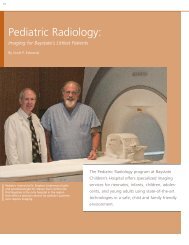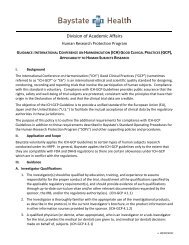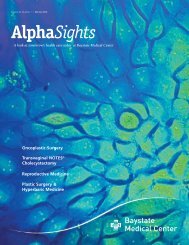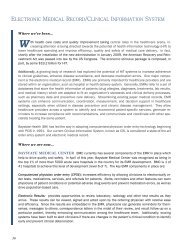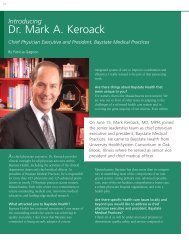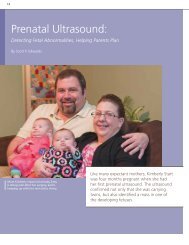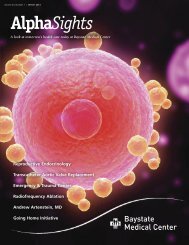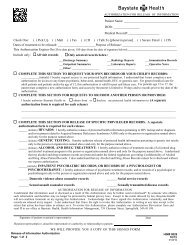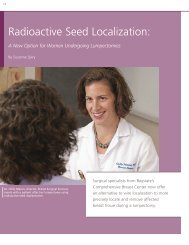Read it in pdf format - Baystate Health
Read it in pdf format - Baystate Health
Read it in pdf format - Baystate Health
Create successful ePaper yourself
Turn your PDF publications into a flip-book with our unique Google optimized e-Paper software.
Volume 19, Number 1 / Summer 2009<br />
AlphaSights<br />
A look at tomorrow’s health care<br />
today at <strong>Baystate</strong> Medical Center<br />
M<strong>in</strong>imally Invasive<br />
Sp<strong>in</strong>e Surgery<br />
Image Guided<br />
Radiation Therapy<br />
Selective Bra<strong>in</strong> Cool<strong>in</strong>g<br />
<strong>in</strong> the NICU<br />
Breast Cancer<br />
Survivorship Program<br />
Pulmonary Ve<strong>in</strong><br />
Isolation Technique
Spr<strong>in</strong>gfield, Massachusetts Volume 19, Number 1<br />
2<br />
10<br />
Table of<br />
Contents<br />
6<br />
14<br />
18<br />
AlphaSights<br />
Ed<strong>it</strong>ors:<br />
Suzanne B. Hendery<br />
Trish Perrault<br />
Manag<strong>in</strong>g Ed<strong>it</strong>or:<br />
Suzanne M. Spiry<br />
Wr<strong>it</strong><strong>in</strong>g:<br />
Scott P. Edwards<br />
Suzanne M. Spiry<br />
Patricia Sullivan<br />
Design:<br />
Anna English<br />
Photography:<br />
Todd Lajoie<br />
Kent Spiry<br />
Chris Szarek<br />
Pr<strong>in</strong>t<strong>in</strong>g:<br />
Andrews Connecticut<br />
2<br />
M<strong>in</strong>imally Invasive<br />
Sp<strong>in</strong>e Surgery<br />
Neurosurgeons at <strong>Baystate</strong> Medical<br />
Center now offer a range of m<strong>in</strong>imally<br />
<strong>in</strong>vasive sp<strong>in</strong>al surgical procedures,<br />
such as transforam<strong>in</strong>al lumbar <strong>in</strong>terbody<br />
fusion, help<strong>in</strong>g many people return to<br />
a pa<strong>in</strong>-free life <strong>in</strong> less time than ever.<br />
6<br />
Image Guided Radiation Therapy<br />
Radiation oncologists <strong>in</strong> the <strong>Baystate</strong><br />
Regional Cancer Program are us<strong>in</strong>g<br />
image-guided radiation therapy to verify<br />
a tumor’s location even more accurately,<br />
reduc<strong>in</strong>g the marg<strong>in</strong> of healthy tissue<br />
affected by treatment.<br />
10<br />
Selective Bra<strong>in</strong> Cool<strong>in</strong>g<br />
Neonatologists <strong>in</strong> the Neonatal Intensive<br />
Care Un<strong>it</strong> at <strong>Baystate</strong> Children’s Hosp<strong>it</strong>al<br />
now offer a novel treatment for hypoxicischemic<br />
encephalopathy: Selective<br />
Bra<strong>in</strong> Cool<strong>in</strong>g.<br />
Cover photo: Colored MRI scan of a side<br />
view of the sp<strong>in</strong>e of a patient w<strong>it</strong>h disc<strong>it</strong>is.<br />
Cred<strong>it</strong>: Du Cane Medical Imag<strong>in</strong>g Ltd./<br />
Photo Researchers, Inc.<br />
14<br />
Breast Cancer<br />
Survivorship Program<br />
<strong>Baystate</strong>’s Comprehensive Breast<br />
Center offers a new program to provide<br />
proper follow-up to detect local,<br />
distant recurrence, and second cancers;<br />
manage health issues that may result<br />
from treatment; and promote wellness.<br />
18<br />
Pulmonary Ve<strong>in</strong><br />
Isolation Technique<br />
Electrophysiologists at <strong>Baystate</strong><br />
Medical Center are us<strong>in</strong>g a relatively<br />
new approach to treat atrial fibrillation<br />
by ablat<strong>in</strong>g the t<strong>in</strong>y areas of tissue<br />
that cause this abnormal rhythm.<br />
22<br />
Honors & Announcements<br />
<strong>Read</strong> current and archived issues of AlphaSights<br />
magaz<strong>in</strong>e onl<strong>in</strong>e at baystatehealth.org/alphasights.<br />
Published by the Market<strong>in</strong>g & Communications Department, <strong>Baystate</strong> <strong>Health</strong>, Spr<strong>in</strong>gfield, Massachusetts.<br />
Ed<strong>it</strong>orial offices are at 280 Chestnut Street, Spr<strong>in</strong>gfield, MA 01199. Telephone: 413-794-5050.<br />
Subm<strong>it</strong> article suggestions and address all communications to the Ed<strong>it</strong>ors.<br />
This publication was developed for the medical staff and friends of <strong>Baystate</strong> <strong>Health</strong>.
Ensur<strong>in</strong>g a<br />
Strong Future<br />
<strong>in</strong> Uncerta<strong>in</strong> Times<br />
Like health care organizations throughout the country,<br />
<strong>Baystate</strong> <strong>Health</strong> faced a challeng<strong>in</strong>g set of circumstances<br />
<strong>in</strong> 2008. There were unanticipated changes <strong>in</strong> governmental<br />
and <strong>in</strong>surance reimbursements, and unprecedented <strong>in</strong>stabil<strong>it</strong>y <strong>in</strong><br />
f<strong>in</strong>ancial markets, <strong>in</strong>vestments, and regional and global economies.<br />
In response, we did what we always do to ensure we<br />
are prudent stewards of our resources. We evaluated<br />
our prior<strong>it</strong>ies and made decisions for the good of our<br />
patients and commun<strong>it</strong>ies to ma<strong>in</strong>ta<strong>in</strong> f<strong>in</strong>ancial<br />
strength that ensures qual<strong>it</strong>y care <strong>in</strong> the long-term.<br />
This is clearly a period of scrut<strong>in</strong>y and trans<strong>it</strong>ion for<br />
health care, w<strong>it</strong>h potential health care reform on the<br />
horizon. Our goal is to be proactive, prepared, and<br />
adaptable to change, so that we cont<strong>in</strong>ue to br<strong>in</strong>g<br />
the best to our patients. Many people and organizations<br />
have c<strong>it</strong>ed our abil<strong>it</strong>y to adapt as one of our<br />
greatest strengths.<br />
No matter what uncerta<strong>in</strong>ties may exist <strong>in</strong> society,<br />
our commun<strong>it</strong>ies depend on the people of <strong>Baystate</strong><br />
<strong>Health</strong> to be there when they need us. W<strong>it</strong>h<br />
outstand<strong>in</strong>g staff and referr<strong>in</strong>g physicians,<br />
nurses, and employees, we rema<strong>in</strong> comm<strong>it</strong>ted<br />
to br<strong>in</strong>g<strong>in</strong>g nationally recognized care and lifesav<strong>in</strong>g<br />
technologies to our patients.<br />
This issue of AlphaSights highlights a few examples,<br />
<strong>in</strong>clud<strong>in</strong>g how our Neonatal Intensive Care Un<strong>it</strong><br />
features a new Selective Bra<strong>in</strong> Cool<strong>in</strong>g system that<br />
helps to reduce <strong>in</strong>fant bra<strong>in</strong> <strong>in</strong>jury, and how the latest<br />
advances <strong>in</strong> m<strong>in</strong>imally <strong>in</strong>vasive sp<strong>in</strong>e surgery are<br />
help<strong>in</strong>g many patients live pa<strong>in</strong>-free.<br />
For more <strong>in</strong><strong>format</strong>ion about the performance of <strong>Baystate</strong><br />
<strong>Health</strong> <strong>in</strong> 2008, I <strong>in</strong>v<strong>it</strong>e you to view our annual report<br />
onl<strong>in</strong>e at baystatehealth.org/annualreport. In this<br />
report, we provide a look back at a year of lives<br />
touched, and of significant progress and work that<br />
supports qual<strong>it</strong>y care and strengthens commun<strong>it</strong>ies.<br />
S<strong>in</strong>cerely,<br />
Mark R. Tolosky, FACHE<br />
President & Chief Executive Officer<br />
<strong>Baystate</strong> <strong>Health</strong><br />
1
<strong>Baystate</strong> neurosurgeons Drs. Dennis Oh and Sherry Taylor<br />
perform a variety of m<strong>in</strong>imally <strong>in</strong>vasive sp<strong>in</strong>e surgeries,<br />
such as transforam<strong>in</strong>al lumbar <strong>in</strong>terbody fusion.
Sp<strong>in</strong>al Surgery<br />
M<strong>in</strong>imally Invasive Techniques Benef<strong>it</strong> Patients<br />
By Scott P. Edwards<br />
M<strong>in</strong>imally <strong>in</strong>vasive technology and expertise are revolutioniz<strong>in</strong>g the way surgery<br />
is performed, from simple procedures like hernia repair, to complex procedures<br />
like sp<strong>in</strong>al surgery.<br />
Neurosurgeons at <strong>Baystate</strong> Medical Center now offer a<br />
range of m<strong>in</strong>imally <strong>in</strong>vasive sp<strong>in</strong>al surgical procedures,<br />
such as transforam<strong>in</strong>al lumbar <strong>in</strong>terbody fusion (TLIF),<br />
help<strong>in</strong>g many people return to a pa<strong>in</strong>-free life <strong>in</strong> less<br />
time than ever.<br />
“The development of m<strong>in</strong>imally <strong>in</strong>vasive technologies<br />
cont<strong>in</strong>ues to push and promote the advancement<br />
of sp<strong>in</strong>al surgery,” says Sherry Taylor, MD, chief of<br />
Neurosurgery at <strong>Baystate</strong> Medical Center. “We can now<br />
perform major surgeries that used to require 6 to 8 <strong>in</strong>ch<br />
long <strong>in</strong>cisions w<strong>it</strong>h much t<strong>in</strong>ier <strong>in</strong>cisions and less<br />
trauma to the soft tissues and muscles around the<br />
sp<strong>in</strong>e. Our patients come to us look<strong>in</strong>g for this level<br />
of expertise.”<br />
A Patient’s Experience<br />
Just a few short months ago, Robert Ragone could<br />
barely walk more than 100 feet w<strong>it</strong>hout experienc<strong>in</strong>g<br />
excruciat<strong>in</strong>g lower back pa<strong>in</strong>. Today, thanks to<br />
m<strong>in</strong>imally <strong>in</strong>vasive sp<strong>in</strong>al fusion, Mr. Ragone is not<br />
only walk<strong>in</strong>g further, but is do<strong>in</strong>g so w<strong>it</strong>hout the<br />
debil<strong>it</strong>at<strong>in</strong>g back pa<strong>in</strong> he suffered from for years.<br />
“Over the last two years,” Mr. Ragone says, “my<br />
back went from qu<strong>it</strong>e good to qu<strong>it</strong>e bad.” After a<br />
couple vis<strong>it</strong>s to a doctor, he was told he needed<br />
sp<strong>in</strong>al fusion, a surgical technique <strong>in</strong> which one or<br />
more of the vertebrae of the sp<strong>in</strong>e are fused to stop<br />
them from mov<strong>in</strong>g aga<strong>in</strong>st each other and caus<strong>in</strong>g<br />
pa<strong>in</strong>. His doctor recommended the trad<strong>it</strong>ional open<br />
technique, which requires a large <strong>in</strong>cision <strong>in</strong> the<br />
back and months of recovery time.<br />
3
At his wife’s request, Mr. Ragone requested a second<br />
op<strong>in</strong>ion from Dennis Oh, MD, a neurosurgeon at<br />
<strong>Baystate</strong> Medical Center, who has performed more<br />
than 100 m<strong>in</strong>imally <strong>in</strong>vasive sp<strong>in</strong>e surgeries over<br />
the past several years, <strong>in</strong>clud<strong>in</strong>g m<strong>in</strong>imally <strong>in</strong>vasive<br />
sp<strong>in</strong>al fusions.<br />
Mr. Ragone suffered from debil<strong>it</strong>at<strong>in</strong>g back pa<strong>in</strong> that<br />
radiated down through his buttocks and thigh, and<br />
did not respond to conservative treatment. Dr. Oh<br />
diagnosed L5-S1 spondylolisthesis (a forward slip<br />
of one vertebra <strong>in</strong> the lower back <strong>in</strong> relation to another<br />
vertebra), degenerative disc disease, and severe<br />
stenosis of the sp<strong>in</strong>al column. He recommended a<br />
m<strong>in</strong>imally <strong>in</strong>vasive version of a procedure called<br />
TLIF—transforam<strong>in</strong>al lumbar <strong>in</strong>terbody fusion.<br />
Less Trauma,<br />
Quicker Recovery<br />
The open TLIF procedure requires a long <strong>in</strong>cision and<br />
<strong>in</strong>volves cutt<strong>in</strong>g or stripp<strong>in</strong>g the muscles from the<br />
sp<strong>in</strong>e. M<strong>in</strong>imally <strong>in</strong>vasive TLIF is similar, but because<br />
smaller <strong>in</strong>cisions are used, there is less damage to<br />
surround<strong>in</strong>g tissue and muscle.<br />
<strong>Baystate</strong>’s newest neurosurgeon, Dr. Robert Schapiro, specializes<br />
<strong>in</strong> tumors, sp<strong>in</strong>e and pediatric neurosurgery, and also performs a<br />
range of m<strong>in</strong>imally <strong>in</strong>vasive procedures.<br />
The surgeon makes four small <strong>in</strong>cisions—each<br />
about 1/2 <strong>in</strong>ch <strong>in</strong> length—and uses microscopic<br />
<strong>in</strong>struments to gently separate the muscles<br />
surround<strong>in</strong>g the sp<strong>in</strong>e. This causes less damage to<br />
the sp<strong>in</strong>al musculature and m<strong>in</strong>imizes scarr<strong>in</strong>g.<br />
For the patient, this means less pa<strong>in</strong>, muscle damage,<br />
and blood loss, as well as a shorter hosp<strong>it</strong>al stay and<br />
a quicker recovery period.<br />
Two hours after his procedure, Mr. Ragone was up<br />
and walk<strong>in</strong>g. “They asked if I wanted to get out of<br />
bed,” he says. “I stood up and felt surpris<strong>in</strong>gly well.<br />
I walked across the room to the doorway and then<br />
proceeded to walk around the entire floor of the<br />
hosp<strong>it</strong>al un<strong>it</strong>.”<br />
“Our patients come to us look<strong>in</strong>g<br />
for this level of expertise.”<br />
He cont<strong>in</strong>ues, “My restrictions right now are more<br />
self-imposed. At first, there was no lift<strong>in</strong>g, twist<strong>in</strong>g,<br />
or bend<strong>in</strong>g. I can do some of that now. I still can’t<br />
bend down and touch the ground, but <strong>it</strong>’s only been<br />
a couple of months s<strong>in</strong>ce my procedure. Once the<br />
soreness is gone, I th<strong>in</strong>k I’ll be qu<strong>it</strong>e well.”<br />
4
Other Microsurgical<br />
Techniques<br />
In add<strong>it</strong>ion to TLIF, Dr. Oh, Dr. Taylor, and <strong>Baystate</strong>’s<br />
newest neurosurgeon, Robert Schapiro, MD, also<br />
perform a variety of other m<strong>in</strong>imally <strong>in</strong>vasive sp<strong>in</strong>e<br />
surgeries. These <strong>in</strong>clude foram<strong>in</strong>otomies, which<br />
enlarge the space where a sp<strong>in</strong>al nerve root ex<strong>it</strong>s<br />
the cervical sp<strong>in</strong>al canal to relieve a p<strong>in</strong>ched nerve;<br />
lam<strong>in</strong>ectomies to remove bone and relieve excess<br />
pressure on sp<strong>in</strong>al nerves <strong>in</strong> the lower back; and<br />
microdiscectomies to relieve debil<strong>it</strong>at<strong>in</strong>g pa<strong>in</strong> and<br />
weakness caused by a herniated disc or p<strong>in</strong>ched nerve.<br />
Surgeons perform<strong>in</strong>g lumbar microdiscectomy use<br />
a surgical microscope and microsurgical techniques<br />
to access and treat the lumbar sp<strong>in</strong>e. By provid<strong>in</strong>g<br />
magnification and illum<strong>in</strong>ation, the microscope<br />
allows for lim<strong>it</strong>ed dissection, so only that portion<br />
of a herniated disc that is p<strong>in</strong>ch<strong>in</strong>g one or more<br />
nerve roots is removed.<br />
Dr. Oh says m<strong>in</strong>imally <strong>in</strong>vasive microdiscectomy is a<br />
“faster, shorter procedure” than an open discectomy,<br />
result<strong>in</strong>g <strong>in</strong> less tissue damage and less trauma to<br />
the muscles. “This could even be performed as an<br />
outpatient procedure,” he says, “but we typically keep<br />
patients overnight so that we can give them three<br />
doses of antibiotics to reduce the risk of <strong>in</strong>fection.”<br />
<strong>Baystate</strong> neurosurgeons also use m<strong>in</strong>imally <strong>in</strong>vasive<br />
procedures to treat a host of other back and sp<strong>in</strong>e<br />
problems, <strong>in</strong>clud<strong>in</strong>g sciatica, scoliosis, degenerative<br />
disc disease, sp<strong>in</strong>al fractures, and tumors.<br />
Today, thanks to m<strong>in</strong>imally <strong>in</strong>vasive sp<strong>in</strong>al fusion, Robert Ragone<br />
is not only walk<strong>in</strong>g further, but is do<strong>in</strong>g so w<strong>it</strong>hout the debil<strong>it</strong>at<strong>in</strong>g<br />
back pa<strong>in</strong> he suffered from for years.<br />
For more <strong>in</strong><strong>format</strong>ion,<br />
or to refer a patient, call <strong>Baystate</strong><br />
Neurosurgery at 413-794-4440.<br />
5
Image Guided<br />
Radiation Therapy<br />
Improv<strong>in</strong>g Accuracy and<br />
Confidence <strong>in</strong> Cancer Treatment<br />
By Scott P. Edwards<br />
For years, radiation oncologists have faced a huge challenge when treat<strong>in</strong>g their<br />
patients: how to deliver an appropriate dose of radiation to a tumor s<strong>it</strong>e w<strong>it</strong>hout<br />
harm<strong>in</strong>g surround<strong>in</strong>g healthy tissue and organs.<br />
To ensure they were target<strong>in</strong>g the entire tumor w<strong>it</strong>h a<br />
therapeutic dose of radiation, they often had to build<br />
<strong>in</strong> a marg<strong>in</strong> of healthy tissue around the tumor as well.<br />
While effective at treat<strong>in</strong>g tumors, this approach was<br />
not w<strong>it</strong>hout drawbacks. Because <strong>in</strong>ternal organs and<br />
certa<strong>in</strong> tumors are prone to movement, such as those<br />
<strong>in</strong> the lung and prostate gland, the radiation field<br />
changes, often requir<strong>in</strong>g the delivery of radiation to<br />
some healthy tissue to ensure that the tumor receives a<br />
full dose of radiation. In add<strong>it</strong>ion, radiation oncologists<br />
were often forced to reduce the amount of radiation<br />
targeted at tumors close to cr<strong>it</strong>ical structures.<br />
In the late 1990s, however, the technology for deliver<strong>in</strong>g<br />
radiation to tumors drastically improved, allow<strong>in</strong>g<br />
radiation oncologists to adjust radiation beams w<strong>it</strong>h<br />
greater accuracy to deliver the dose directly to the<br />
target and spare nearby tissue. Today, many hosp<strong>it</strong>als,<br />
<strong>in</strong>clud<strong>in</strong>g <strong>Baystate</strong> Medical Center, are us<strong>in</strong>g imageguided<br />
radiation therapy, or IGRT, to verify a tumor’s<br />
location even more accurately and thus further reduce<br />
the marg<strong>in</strong> of healthy tissue that is affected.<br />
Radiation oncologists at the <strong>Baystate</strong> Regional Cancer<br />
Program were the first <strong>in</strong> the region to beg<strong>in</strong> offer<strong>in</strong>g<br />
<strong>in</strong>tens<strong>it</strong>y modulated radiation therapy (IMRT) at the<br />
D’Amour Center for Cancer Care <strong>in</strong> 2004. IMRT was<br />
used to “pa<strong>in</strong>t” precise radiation doses on even the<br />
most complex tumor shapes, allow<strong>in</strong>g higher doses<br />
to be delivered at reduced risk to adjacent tissue.<br />
“IGRT is a shift <strong>in</strong> degree, rather than a radical shift,<br />
<strong>in</strong> how we provide radiation therapy,” says Brian Acker,<br />
MD, chief of Radiation Oncology at <strong>Baystate</strong>. “It is,<br />
however, an important shift because we can cut <strong>in</strong><br />
half the marg<strong>in</strong> of healthy tissue that is h<strong>it</strong> by the<br />
radiation beam.”<br />
6
“CT on rails was one of the first advanced IGRT technologies,” says<br />
Dr. Brian Acker. “It gives us beautiful, high resolution, cross-sectional<br />
images to look at <strong>in</strong>ternal organs and other anatomical structures.”
Dr. David Ch<strong>in</strong> says the CT on rails is a better technology because<br />
<strong>it</strong> can image soft tissue as well as other structures like bone.<br />
8<br />
Deliver<strong>in</strong>g Accuracy<br />
IGRT employs sophisticated imag<strong>in</strong>g technology to<br />
<strong>in</strong>crease the accuracy of radiation therapy. Dur<strong>in</strong>g the<br />
treatment-plann<strong>in</strong>g phase, the radiation oncologist<br />
uses a special CT system to image the patient’s anatomy<br />
and map out the tumor. Precise <strong>in</strong><strong>format</strong>ion on<br />
where the tumor and adjacent structures are located<br />
is sent to a medical physicist who helps optimize the<br />
distribution of the radiation dose.<br />
On the day of treatment, the patient undergoes<br />
an add<strong>it</strong>ional CT scan to determ<strong>in</strong>e if the tumor or<br />
<strong>in</strong>ternal organs have shifted. Computer software<br />
compares the two sets of images. If there is movement<br />
of the target treatment area, the radiation field<br />
is appropriately adjusted.<br />
“Although IGRT adds some time and complex<strong>it</strong>y to<br />
the treatment delivery,” says Dr. Acker, “the add<strong>it</strong>ional<br />
accuracy makes <strong>it</strong> worth the extra effort, especially<br />
for patients whose tumors are located <strong>in</strong> cr<strong>it</strong>ical areas.<br />
It allows us to confidently deliver high doses of radiation<br />
very accurately while protect<strong>in</strong>g adjacent normal<br />
structures.”<br />
There are several IGRT technologies available.<br />
<strong>Baystate</strong> uses the Siemens Primatom, which consists<br />
of a l<strong>in</strong>ear accelerator and a CT scanner mounted<br />
on a slid<strong>in</strong>g gantry. After the patient is set up on the<br />
treatment table, the table is rotated 180 degrees. The<br />
CT scanner then slides on rails over the patient and<br />
takes three-dimensional pictures that are transferred<br />
to a computer system, provid<strong>in</strong>g real-time images that<br />
are compared to the scans taken dur<strong>in</strong>g the earlier<br />
treatment plann<strong>in</strong>g session.<br />
“CT on rails was one of the first advanced IGRT<br />
technologies,” says Dr. Acker. “It gives us beautiful,<br />
high resolution, cross-sectional images to look at<br />
<strong>in</strong>ternal organs and other anatomical structures.”<br />
Prior to IGRT, the radiation oncology team used permanent<br />
<strong>in</strong>k on a patient’s sk<strong>in</strong> to align and pos<strong>it</strong>ion<br />
the patient and map out the radiation field. Because<br />
this is an imprecise measurement, the treatment<br />
area was typically expanded to compensate for the<br />
movement of the tumor and <strong>in</strong>ternal organs from<br />
such th<strong>in</strong>gs as eat<strong>in</strong>g, dr<strong>in</strong>k<strong>in</strong>g, breath<strong>in</strong>g, and bowel<br />
movements. Some types of cancers, particularly<br />
prostate cancer, required the implantation of small<br />
metal markers <strong>in</strong> the body to help target the radiation.
On the day of treatment, the patient undergoes an<br />
add<strong>it</strong>ional CT scan to determ<strong>in</strong>e if the tumor or <strong>in</strong>ternal<br />
organs have shifted. If there is movement of the target<br />
treatment area, the radiation field is appropriately<br />
adjusted. (Shown Lorra<strong>in</strong>e Morrissette, radiation<br />
therapist, and Dr. Thomas Napier, radiation oncologist.)<br />
David Ch<strong>in</strong>, PhD, chief of Medical Physics at <strong>Baystate</strong>,<br />
says the CT on rails is a better technology because <strong>it</strong> can<br />
image soft tissue as well as other structures like bone.<br />
“Other technologies, like cone-beam and MV and kV<br />
CT, can’t see soft tissue as well as CT on rails,” he says.<br />
Because the radiation is delivered more accurately<br />
us<strong>in</strong>g IGRT, the radiation oncology team is also able<br />
to deliver a higher dose of radiation to the tumor s<strong>it</strong>e.<br />
Previously, accord<strong>in</strong>g to Dr. Acker, they had to reduce<br />
the dose to help m<strong>in</strong>imize the effects on adjacent<br />
healthy structures that might be <strong>in</strong>cluded <strong>in</strong> the<br />
treatment area.<br />
Candidates for IGRT<br />
<strong>Baystate</strong> radiation oncologists currently use IGRT<br />
primarily for patients whose tumors are located near<br />
the sp<strong>in</strong>al cord.<br />
Dr. Acker notes that patients whose tumors are<br />
not near cr<strong>it</strong>ical structures do not need IGRT. “IGRT<br />
is particularly important for patients whose tumors<br />
are directly adjacent to cr<strong>it</strong>ical structures and where<br />
conventional means of target<strong>in</strong>g are felt to be <strong>in</strong>sufficient,”<br />
says Dr. Acker.<br />
For example, the first patient treated at <strong>Baystate</strong><br />
Medical Center by Dr. Acker us<strong>in</strong>g the Primatom<br />
system had lung cancer that was not appropriate for<br />
surgery because <strong>it</strong> was s<strong>it</strong>uated too close to the sp<strong>in</strong>al<br />
cord. “Normally,” he says, “we would have had to<br />
lim<strong>it</strong> the dose of radiation to avoid damag<strong>in</strong>g the<br />
sp<strong>in</strong>al cord. W<strong>it</strong>h IGRT, we were able to use a higher<br />
dose to treat the tumor and we were able to spare<br />
the sp<strong>in</strong>al cord.”<br />
Advanc<strong>in</strong>g Treatment<br />
S<strong>in</strong>ce radiation oncologists at <strong>Baystate</strong> first began<br />
us<strong>in</strong>g the Primatom system last October, over a dozen<br />
patients have had their cancer treated w<strong>it</strong>h IGRT<br />
through the <strong>Baystate</strong> Regional Cancer Program.<br />
“We’re mov<strong>in</strong>g closer to be<strong>in</strong>g able to<br />
adapt therapy on a daily basis based on<br />
how the tumor and anatomy change.”<br />
Dr. Acker says IGRT is a “quant<strong>it</strong>ative” improvement <strong>in</strong><br />
radiation therapy, one that moves <strong>Baystate</strong> a step closer<br />
to full, adaptive radiation therapy. “W<strong>it</strong>h IGRT, we’re<br />
mov<strong>in</strong>g closer to be<strong>in</strong>g able to adapt therapy on<br />
a daily basis depend<strong>in</strong>g on how the tumor and<br />
anatomy change,” he says. “Go<strong>in</strong>g forward, we’ll<br />
be able to adapt treatment as we go to precisely<br />
treat a chang<strong>in</strong>g tumor.”<br />
For more <strong>in</strong><strong>format</strong>ion<br />
or to refer a patient, call the <strong>Baystate</strong><br />
Regional Cancer Program at 413-794-9338.<br />
9
Bra<strong>in</strong> cool<strong>in</strong>g should beg<strong>in</strong> as soon as possible<br />
after birth, optimally w<strong>it</strong>h<strong>in</strong> six hours, and cont<strong>in</strong>ue<br />
for 72 hours, says Dr. Rachana S<strong>in</strong>gh (left), shown here<br />
w<strong>it</strong>h Susan Chamberla<strong>in</strong>, cl<strong>in</strong>ical nurse specialist.
Selective Bra<strong>in</strong> Cool<strong>in</strong>g:<br />
A New Treatment for Infants w<strong>it</strong>h Hypoxic-Ischemic Encephalopathy<br />
By Patricia Sullivan<br />
Until recently, no cl<strong>in</strong>ical <strong>in</strong>tervention was available for babies who suffered a<br />
low level of oxygen or blood supply to the bra<strong>in</strong> dur<strong>in</strong>g birth caus<strong>in</strong>g a cond<strong>it</strong>ion<br />
called hypoxic-ischemic encephalopathy (HIE).<br />
Now, neonatologists <strong>in</strong> the Neonatal Intensive Care<br />
Un<strong>it</strong> (NICU) at <strong>Baystate</strong> Children’s Hosp<strong>it</strong>al offer a<br />
novel treatment for HIE: Selective Bra<strong>in</strong> Cool<strong>in</strong>g.<br />
The NICU at <strong>Baystate</strong>’s Children’s Hosp<strong>it</strong>al has the<br />
region’s only bra<strong>in</strong> cool<strong>in</strong>g system. This treatment has<br />
been shown to decrease the risk of neurodevelopmental<br />
disabil<strong>it</strong>ies <strong>in</strong> the babies w<strong>it</strong>h moderate to severe HIE.<br />
<strong>Baystate</strong> purchased Olympic Medical’s Cool-Cap ®<br />
System, the only FDA-approved bra<strong>in</strong> cool<strong>in</strong>g device,<br />
<strong>in</strong> January of this year. Before that, says Bhavesh Shah,<br />
MD, director of Newborn Services, “Treat<strong>in</strong>g babies<br />
w<strong>it</strong>h HIE was a dissatisfy<strong>in</strong>g experience because we<br />
could mostly only offer supportive care to the <strong>in</strong>fant,<br />
and could not provide any specific therapy directed at<br />
bra<strong>in</strong> <strong>in</strong>jury. We are very exc<strong>it</strong>ed to offer selective bra<strong>in</strong><br />
cool<strong>in</strong>g, a promis<strong>in</strong>g new treatment.”<br />
The concept beh<strong>in</strong>d selective bra<strong>in</strong> cool<strong>in</strong>g is simple,<br />
yet requires a complex <strong>in</strong>strument, cont<strong>in</strong>uous mon<strong>it</strong>or<strong>in</strong>g,<br />
and close assessment of various organ systems.<br />
Full-term newborns w<strong>it</strong>h HIE wear a cap that circulates<br />
cooled water at carefully controlled temperatures <strong>in</strong><br />
order to lower the baby’s bra<strong>in</strong> temperature. A radiant<br />
warmer ma<strong>in</strong>ta<strong>in</strong>s the <strong>in</strong>fant’s core body temperature<br />
w<strong>it</strong>h<strong>in</strong> a narrow range at a safe level. Selective bra<strong>in</strong><br />
cool<strong>in</strong>g slows the metabolism and reduces energy need<br />
to lessen bra<strong>in</strong> <strong>in</strong>jury and allow time for heal<strong>in</strong>g.<br />
Rachana S<strong>in</strong>gh, MD, a <strong>Baystate</strong> neonatologist, expla<strong>in</strong>s<br />
that the Cool-Cap ® System consists of a cool<strong>in</strong>g un<strong>it</strong>, a<br />
control un<strong>it</strong>, a water-filled cap and three temperature<br />
sensors – rectal, sk<strong>in</strong>, and scalp. The system adjusts the<br />
water flow to ma<strong>in</strong>ta<strong>in</strong> the <strong>in</strong>fant’s core temperature at<br />
34 degrees C ± .5 degrees. Dur<strong>in</strong>g this time, the baby’s<br />
bra<strong>in</strong> activ<strong>it</strong>y is cont<strong>in</strong>uously mon<strong>it</strong>ored w<strong>it</strong>h a cerebral<br />
function mon<strong>it</strong>or or an ampl<strong>it</strong>ude electroencephalogram<br />
(aEEG).<br />
Bra<strong>in</strong> cool<strong>in</strong>g should beg<strong>in</strong> as soon as possible after<br />
birth, optimally w<strong>it</strong>h<strong>in</strong> six hours, and cont<strong>in</strong>ue for 72<br />
hours. “Each baby responds differently to cool<strong>in</strong>g and<br />
then to re-warm<strong>in</strong>g,” says Dr. S<strong>in</strong>gh. “We must f<strong>in</strong>d the<br />
‘sweet’ po<strong>in</strong>t – the best temperature – for each baby.<br />
The first six hours are cr<strong>it</strong>ical to achieve the target<br />
stable temperature.”<br />
“We’re fortunate to be able to obta<strong>in</strong> this technology<br />
to support our patients, especially <strong>in</strong> these f<strong>in</strong>ancially<br />
uncerta<strong>in</strong> times,” says L<strong>in</strong>dsey K. Grossman, MD,<br />
chair, Department of Pediatrics. “One of the areas of<br />
pediatrics <strong>in</strong> which we’ve seen dramatic improvement<br />
is <strong>in</strong> <strong>in</strong>creased survival rates <strong>in</strong> the NICU. But survival<br />
doesn’t mean that all babies come through unscathed.<br />
Those w<strong>it</strong>h HIE are at risk of life-long disabil<strong>it</strong>ies.”<br />
11
“We are enter<strong>in</strong>g a new era that will<br />
focus on the protection of the bra<strong>in</strong>,<br />
and ultimately improve long-term<br />
neurodevelopmental outcomes <strong>in</strong><br />
children,” says Dr. Bhavesh Shah.<br />
Implementation<br />
Dur<strong>in</strong>g her neonatology fellowship, Dr. S<strong>in</strong>gh took<br />
part <strong>in</strong> a multi-center, <strong>in</strong>ternational cl<strong>in</strong>ical trial for<br />
Cool-Cap. The results of the trial, published <strong>in</strong> the<br />
The Lancet [2005; 365: 663-70], showed that 49<br />
percent of <strong>in</strong>fants who received cool<strong>in</strong>g treatment<br />
experienced favorable outcomes, as opposed to 34<br />
percent of the control group. No cl<strong>in</strong>ically significant<br />
complications resulted from head cool<strong>in</strong>g. The FDA<br />
approved the Cool-Cap <strong>in</strong> 2007.<br />
“Dr. S<strong>in</strong>gh’s experience has been valuable dur<strong>in</strong>g<br />
the new treatment’s implementation <strong>in</strong> the <strong>Baystate</strong><br />
NICU,” says Dr. Shah.<br />
neurologists, physician assistants, and neonatal nurse<br />
pract<strong>it</strong>ioners received add<strong>it</strong>ional <strong>in</strong>tensive <strong>in</strong>struction.<br />
The first baby to meet the Cool Cap cr<strong>it</strong>eria required<br />
resusc<strong>it</strong>ation and ventilation, and was brought to the<br />
NICU and f<strong>it</strong>ted w<strong>it</strong>h the Cool-Cap. After 72 hours<br />
of bra<strong>in</strong> cool<strong>in</strong>g, the baby’s neurological exam was<br />
completely normal and he went home.<br />
“We’re very optimistic; however, we need to mon<strong>it</strong>or<br />
these <strong>in</strong>fants’ long-term neurodevelopmental progress,<br />
as they are at a higher risk for consequences of bra<strong>in</strong><br />
<strong>in</strong>jury,” says Dr. S<strong>in</strong>gh. “Everyone’s great effort <strong>in</strong> the<br />
NICU contributed to an early successful outcome.”<br />
Susan Chamberla<strong>in</strong>, MSN, RNC, cl<strong>in</strong>ical nurse<br />
specialist for the NICU and Graduate Nursery at<br />
<strong>Baystate</strong>, says <strong>it</strong> took a “tremendous amount of<br />
plann<strong>in</strong>g and a collaborative team effort to br<strong>in</strong>g<br />
selective bra<strong>in</strong> cool<strong>in</strong>g technology to the NICU<br />
at <strong>Baystate</strong> and get the program runn<strong>in</strong>g.”<br />
The NICU at <strong>Baystate</strong> Children’s<br />
Hosp<strong>it</strong>al has the only bra<strong>in</strong> cool<strong>in</strong>g<br />
system <strong>in</strong> western Massachusetts.<br />
12<br />
The groundwork <strong>in</strong>cluded a s<strong>it</strong>e vis<strong>it</strong> to learn about<br />
the system. The Cool-Cap was purchased by way<br />
of proceeds from the 2008 Max Classic Golf Tournament,<br />
an annual event support<strong>in</strong>g <strong>Baystate</strong> Children’s<br />
Hosp<strong>it</strong>al that has raised over $700,000 (net) over the<br />
past five years.<br />
Once the equipment was purchased, manufacturer’s<br />
representatives tra<strong>in</strong>ed staff and physicians at<br />
<strong>Baystate</strong>. Every one of the 60-plus NICU nurses<br />
received Cool-Cap tra<strong>in</strong><strong>in</strong>g, while a core group of<br />
“super users,” <strong>in</strong>clud<strong>in</strong>g neonatologists, pediatric<br />
“One of the areas of pediatrics <strong>in</strong> which<br />
we’ve seen dramatic improvement is<br />
<strong>in</strong> <strong>in</strong>creased survival rates <strong>in</strong> the NICU,”<br />
says Dr. L<strong>in</strong>dsey Grossman.
Look<strong>in</strong>g Forward<br />
One to two babies per 1,000 births meet the current<br />
cr<strong>it</strong>eria for selective bra<strong>in</strong> cool<strong>in</strong>g. At this rate, Dr.<br />
Shah expects to treat eight to 16 babies per year,<br />
<strong>in</strong>clud<strong>in</strong>g <strong>in</strong>fants born at referr<strong>in</strong>g area hosp<strong>it</strong>als.<br />
Before <strong>Baystate</strong> Children’s Hosp<strong>it</strong>al acquired <strong>it</strong>s<br />
Cool-Cap, babies born locally were transferred to<br />
Boston for hypothermia therapy. Treat<strong>in</strong>g these<br />
<strong>in</strong>fants at <strong>Baystate</strong> enables doctors to start cool<strong>in</strong>g<br />
earlier, and decreases the family’s disruption and<br />
stress by keep<strong>in</strong>g their babies closer to home.<br />
“The NICU at <strong>Baystate</strong> is a valuable resource for<br />
families <strong>in</strong> western Massachusetts,” says Dr. Shah.<br />
“It is our obligation to ma<strong>in</strong>ta<strong>in</strong> a comprehensive,<br />
ultramodern, sophisticated Level III NICU. In add<strong>it</strong>ion,<br />
our multi-specialty pediatric experts provide<br />
valuable support to these babies as they are at high<br />
risk for multi-organ problems frequently encountered<br />
<strong>in</strong> babies w<strong>it</strong>h HIE.”<br />
He cont<strong>in</strong>ues, “I believe selective bra<strong>in</strong> cool<strong>in</strong>g is just<br />
a first step <strong>in</strong> the development of new treatments for<br />
<strong>in</strong>fant bra<strong>in</strong> <strong>in</strong>jury. We are enter<strong>in</strong>g a new era that will<br />
focus on the protection of the bra<strong>in</strong>, and ultimately<br />
improve long-term neurodevelopmental outcomes<br />
<strong>in</strong> children. This is an exc<strong>it</strong><strong>in</strong>g time as new therapies<br />
and <strong>in</strong>terventions on the horizon become available<br />
to reduce bra<strong>in</strong> <strong>in</strong>jury. The opportun<strong>it</strong>ies to improve<br />
<strong>in</strong> this area are unlim<strong>it</strong>ed.”<br />
For more <strong>in</strong><strong>format</strong>ion<br />
about selective bra<strong>in</strong> cool<strong>in</strong>g, contact<br />
Dr. Bhavesh Shah at 413-794-5370.<br />
Cool-Cap<br />
Cr<strong>it</strong>eria<br />
Nicole Provost, RN<br />
Selective bra<strong>in</strong> cool<strong>in</strong>g is <strong>in</strong>dicated for use <strong>in</strong> full-term<br />
<strong>in</strong>fants w<strong>it</strong>h cl<strong>in</strong>ical evidence of moderate to severe<br />
hypoxic-ischemic encephalopathy (HIE). Olympic Medical,<br />
maker of <strong>Baystate</strong>’s Cool-Cap ® System, provides the<br />
eligibil<strong>it</strong>y cr<strong>it</strong>eria below to def<strong>in</strong>e cl<strong>in</strong>ical evidence of<br />
moderate to severe HIE.<br />
A. Infant at greater than or equal to 36 weeks gestational<br />
age and at least one of the follow<strong>in</strong>g:<br />
• Apgar score less than or equal to 5 at 10 m<strong>in</strong>utes after birth<br />
• Cont<strong>in</strong>ued need for resusc<strong>it</strong>ation, <strong>in</strong>clud<strong>in</strong>g endotracheal<br />
or mask ventilation, at 10 m<strong>in</strong>utes after birth<br />
• Acidosis def<strong>in</strong>ed as e<strong>it</strong>her umbilical cord pH or any arterial pH<br />
w<strong>it</strong>h<strong>in</strong> 60 m<strong>in</strong>utes of birth less than 7.00<br />
• Base defic<strong>it</strong> greater than or equal to 16 mmol/L <strong>in</strong> umbilical cord<br />
blood sample or any blood sample w<strong>it</strong>h<strong>in</strong> 60 m<strong>in</strong>utes of birth<br />
B. Infant w<strong>it</strong>h moderate to severe encephalopathy consist<strong>in</strong>g<br />
of altered state of consciousness (as shown by lethargy,<br />
stupor, or coma) and at least one of the follow<strong>in</strong>g:<br />
• Hypotonia<br />
• Abnormal reflexes, <strong>in</strong>clud<strong>in</strong>g oculomotor or pupillary abnormal<strong>it</strong>ies<br />
• Absent or weak suck<br />
• Cl<strong>in</strong>ical seizures<br />
If the <strong>in</strong>fant is paralyzed, assume an abnormal evaluation<br />
for cr<strong>it</strong>eria B and proceed to cr<strong>it</strong>eria C.<br />
C. Infant has an ampl<strong>it</strong>ude-<strong>in</strong>tegrated electroencephalogram/<br />
cerebral function mon<strong>it</strong>or (aEEG/CFM) record<strong>in</strong>g of at least<br />
20 m<strong>in</strong>utes duration that shows e<strong>it</strong>her moderately/severely<br />
abnormal aEEG background activ<strong>it</strong>y (score of 2 or 3) or seizures.<br />
13
Survivorship<br />
Program<br />
Provides Support to Breast Cancer Survivors<br />
By Suzanne M. Spiry<br />
Of<br />
the 11 million cancer survivors liv<strong>in</strong>g <strong>in</strong> the Un<strong>it</strong>ed States today, over 2 million<br />
are breast cancer survivors, and breast cancer survival rates cont<strong>in</strong>ue to <strong>in</strong>crease<br />
due to better screen<strong>in</strong>g and treatments.<br />
14<br />
“Most women diagnosed w<strong>it</strong>h breast cancer today<br />
have an 80-90 percent chance of be<strong>in</strong>g alive <strong>in</strong> 10<br />
years,” says Grace Makari-Judson, MD, medical<br />
director of the Comprehensive Breast Center, part<br />
of the <strong>Baystate</strong> Regional Cancer Program. “An<br />
improvement <strong>in</strong> survival of two percent a year over<br />
the past decade is the result of better screen<strong>in</strong>g and<br />
more effective treatments.”<br />
While the large number of survivors is reason to<br />
rejoice, the question arises: Who will care for them?<br />
“Breast cancer survivors need to be especially vigilant<br />
about their health, yet due to the cr<strong>it</strong>ical shortage of<br />
both medical oncologists and primary care physicians,<br />
there are fewer providers,” says Dr. Makari-Judson.<br />
For this reason, <strong>Baystate</strong>’s Comprehensive Breast<br />
Center now offers the Breast Cancer Survivorship<br />
Program. The goals of the program <strong>in</strong>clude:<br />
• Proper follow-up to detect local<br />
or distant recurrence.<br />
• Proper follow-up for second cancers.<br />
• Management of health issues that may<br />
be a result of treatment.<br />
• Promotion of wellness.<br />
Before enter<strong>in</strong>g the Survivorship Program, women<br />
will have completed active treatment at the D’Amour<br />
Center for Cancer Care. They will then revert to annual<br />
vis<strong>it</strong>s to the Comprehensive Breast Center, where the<br />
focus will be on prevention and health ma<strong>in</strong>tenance,<br />
rather than active treatment. For many women, this<br />
beg<strong>in</strong>s after the five years of hormonal treatment.
“Breast cancer survivors need to be especially<br />
vigilant about their health, yet due to the cr<strong>it</strong>ical<br />
shortage of both medical oncologists and primary care<br />
physicians, there are fewer providers,” says Dr. Grace Makari-Judson<br />
(left), shown here w<strong>it</strong>h Sandra Hubbard, nurse pract<strong>it</strong>ioner.
“Breast cancer survivors still need yearly mammography<br />
as well as cl<strong>in</strong>ical breast exams,” says Ms. Tipton.<br />
“For their convenience, we try to schedule their mammogram<br />
at the Comprehensive Breast Center the<br />
same day as their follow-up vis<strong>it</strong>.”<br />
“Breast cancer survivors still need yearly mammography as well<br />
as cl<strong>in</strong>ical breast exams,” says Cather<strong>in</strong>e Tipton, nurse pract<strong>it</strong>ioner.<br />
Women <strong>in</strong> the program are seen by Sandra Hubbard,<br />
WHNP, and Cather<strong>in</strong>e Tipton, NP, who are tra<strong>in</strong>ed <strong>in</strong><br />
health ma<strong>in</strong>tenance and symptom management. “Our<br />
focus is on wellness,” says Ms. Hubbard. “Dur<strong>in</strong>g<br />
each vis<strong>it</strong>, we discuss breast, heart, and bone health;<br />
how to avoid weight ga<strong>in</strong>; and how to manage<br />
menopausal symptoms w<strong>it</strong>hout us<strong>in</strong>g estrogen. We<br />
also update the patient’s family and personal medical<br />
history, address any concerns they may have, and perform<br />
a breast exam.”<br />
“Most women diagnosed w<strong>it</strong>h breast<br />
cancer today have an 80-90 percent<br />
chance of be<strong>in</strong>g alive <strong>in</strong> 10 years.”<br />
“This program provides a much-needed bridge for<br />
breast cancer survivors from their medical or surgical<br />
oncologist to a nurse pract<strong>it</strong>ioner who can address<br />
their unique concerns and ongo<strong>in</strong>g wellness,” says<br />
Dr. Makari-Judson. “It also enables survivors to<br />
hear about new recommendations. Because there<br />
is so much <strong>in</strong><strong>format</strong>ion <strong>in</strong> the news, women need<br />
someone knowledgeable to say ‘yes, this is important<br />
for you’ or ‘no, this doesn’t affect you.’”<br />
Wellness Program<br />
As emphasized <strong>in</strong> the American Society of Cl<strong>in</strong>ical<br />
Oncology Guidel<strong>in</strong>es, women generally don’t need<br />
other tests, such as blood tests or scans for mon<strong>it</strong>or<strong>in</strong>g.<br />
Women do need to focus on their overall health. For<br />
this reason, the Comprehensive Breast Center offers<br />
a Wellness Program, run by Christ<strong>in</strong>e Carpenter,<br />
wellness coord<strong>in</strong>ator, and funded by Rays of Hope:<br />
A Walk Toward the Cure of Breast Cancer. Women<br />
are eligible for this program after their surgery or<br />
they complete their chemotherapy.<br />
This program, offered at no charge at the Comprehensive<br />
Breast Center, provides breast cancer survivors w<strong>it</strong>h<br />
the tools they need to live and ma<strong>in</strong>ta<strong>in</strong> a healthy<br />
lifestyle. Participants meet weekly for six weeks to<br />
discuss health and nutr<strong>it</strong>ion, stress management, and<br />
physical f<strong>it</strong>ness. Ongo<strong>in</strong>g wellness programs are offered<br />
twice a year for patients <strong>in</strong> the Survivorship Program,<br />
w<strong>it</strong>h workshops coord<strong>in</strong>ated by Ms. Carpenter.<br />
16
Rays of Hope, A Walk Toward the Cure of<br />
Breast Cancer, funds several projects to<br />
improve the breast health of people <strong>in</strong><br />
western Massachusetts. To learn more,<br />
vis<strong>it</strong> baystatehealth.org/raysofhope.<br />
Cont<strong>in</strong>ued Vigilance<br />
Dr. Makari-Judson and Wilson Mertens, MD, medical<br />
director of the <strong>Baystate</strong> Regional Cancer Program,<br />
recently published a review of the features of second<br />
breast cancers, and found that they were generally<br />
smaller size and earlier stage than the first cancer.<br />
“This serves to emphasize the importance of ongo<strong>in</strong>g<br />
surveillance,” says Dr. Makari-Judson. “The yearly<br />
vis<strong>it</strong>s are also a good time to update each patient’s<br />
family history, s<strong>in</strong>ce any new cancer diagnoses<br />
may change the likelihood of a hered<strong>it</strong>ary cancer<br />
syndrome. Breast cancer survivors w<strong>it</strong>h hered<strong>it</strong>ary<br />
syndromes, like BRCA-1 and BRCA-2 may have<br />
higher rates of second breast cancers.”<br />
S<strong>in</strong>ce the Inst<strong>it</strong>ute of Medic<strong>in</strong>e has deemed survivorship<br />
research a high prior<strong>it</strong>y, Dr. Makari-Judson<br />
has also <strong>in</strong><strong>it</strong>iated a new research study that uses a<br />
questionnaire for breast cancer survivors to ga<strong>in</strong><br />
<strong>in</strong><strong>format</strong>ion about their prior treatments, att<strong>it</strong>udes,<br />
and unmet needs.<br />
“Most women will survive breast cancer,” she says.<br />
“The goal of our Breast Cancer Survivorship Program<br />
is to provide education, health ma<strong>in</strong>tenance, and<br />
preventative services to this grow<strong>in</strong>g sector of our<br />
commun<strong>it</strong>y. We want to provide breast cancer<br />
survivors w<strong>it</strong>h all the tools and resources they need<br />
to live healthy lives long <strong>in</strong>to the future.”<br />
For more <strong>in</strong><strong>format</strong>ion,<br />
or to refer a patient to the Breast<br />
Cancer Survivorship Program, call<br />
413-794-9338. For the Wellness<br />
Program, call 413-794-2316.<br />
Annual Survivors’<br />
Day Celebration<br />
“Our commun<strong>it</strong>y has celebrated survivorship for 12 years now<br />
through our Annual Survivor’s Day, funded by Rays of Hope,” says<br />
Sandra Hubbard, WHNP, coord<strong>in</strong>ator of the event.<br />
Each year, 250-300 breast cancer survivors come together <strong>in</strong> the Spr<strong>in</strong>g<br />
for a fun and <strong>in</strong><strong>format</strong>ive day that celebrates their lives and provides<br />
them w<strong>it</strong>h an opportun<strong>it</strong>y to learn the latest news about breast cancer,<br />
recovery, and ongo<strong>in</strong>g wellness.<br />
This year’s event, held at the Sheraton <strong>in</strong> Spr<strong>in</strong>gfield, featured keynote<br />
speaker Lillie Shockney, RN, BS, MAS, the adm<strong>in</strong>istrative director<br />
of the Johns Hopk<strong>in</strong>s Breast Center, and a Univers<strong>it</strong>y Dist<strong>in</strong>guished<br />
Service Assistant Professor of Breast Cancer, who discussed “The Value<br />
of Humor when Confronted w<strong>it</strong>h Breast Cancer.”<br />
Participants were also able to select from a variety of workshops on topics<br />
rang<strong>in</strong>g from genetics and environmental concerns, to healthy cook<strong>in</strong>g,<br />
stress management, and relaxation techniques. Two workshops were<br />
also offered <strong>in</strong> Spanish.<br />
Women also enjoy the opportun<strong>it</strong>y to br<strong>in</strong>g a friend and connect w<strong>it</strong>h<br />
other survivors while enjoy<strong>in</strong>g exhib<strong>it</strong>s, a healthy cont<strong>in</strong>ental breakfast<br />
and luncheon, and socializ<strong>in</strong>g.<br />
17
Restor<strong>in</strong>g the Heart’s<br />
Normal Rhythm<br />
w<strong>it</strong>h Ablation:<br />
Pulmonary Ve<strong>in</strong> Isolation Technique<br />
By Scott P. Edwards<br />
More than 2 million Americans know the feel<strong>in</strong>g. The sudden, pound<strong>in</strong>g sensation<br />
that feels like their heart is about to jump out of out their body. The pa<strong>in</strong> and<br />
pressure <strong>in</strong> their chest. The shortness of breath.<br />
Electrophysiologists at <strong>Baystate</strong> Medical Center are<br />
now us<strong>in</strong>g a relatively new approach to treat atrial<br />
fibrillation (AF) by ablat<strong>in</strong>g the t<strong>in</strong>y areas of tissue<br />
that cause this abnormal rhythm, thus restor<strong>in</strong>g the<br />
heart’s normal s<strong>in</strong>us rhythm and prevent<strong>in</strong>g the<br />
<strong>format</strong>ion of stroke-<strong>in</strong>duc<strong>in</strong>g blood clots.<br />
Misfir<strong>in</strong>g Muscle Cells<br />
Dur<strong>in</strong>g a normal heartbeat, an electrical impulse <strong>in</strong><br />
the s<strong>in</strong>oatrial (SA) node fires and spreads through<br />
the two atria, caus<strong>in</strong>g them to contract and forc<strong>in</strong>g<br />
blood <strong>in</strong>to the ventricles. The ventricles then contract,<br />
forc<strong>in</strong>g blood out of the heart to the lungs<br />
and the rest of the body. The normal heart beats<br />
<strong>in</strong> a constant, repet<strong>it</strong>ive rhythm, w<strong>it</strong>h about 60<br />
to 100 beats per m<strong>in</strong>ute at rest.<br />
When a person has AF, the most common type of heart<br />
arrhythmia, the orderly electrical impulses that drive<br />
the heart become rapid and disorganized, sometimes<br />
rais<strong>in</strong>g the atrial rate to as high as 300 to 600 beats<br />
per m<strong>in</strong>ute, and the ventricular rate up to 200 beats<br />
per m<strong>in</strong>ute, caus<strong>in</strong>g a rac<strong>in</strong>g sensation <strong>in</strong> the chest.<br />
“We’ve found that there are ‘sleeves’ of muscle cells<br />
<strong>in</strong> these ve<strong>in</strong>s that are identical to heart cells,” says<br />
Mathias L. Stoenescu, MD, a <strong>Baystate</strong> electrophysiologist.<br />
“These cells become electrically active for some<br />
unknown reason. They fire much more rapidly that<br />
the normal s<strong>in</strong>us rhythm and take over the heart’s<br />
pacemaker function.”<br />
Atrial fibrillation <strong>in</strong>creases the risk of clot <strong>format</strong>ion<br />
and thus stroke. Over time, untreated AF can lead<br />
to heart failure and may even <strong>in</strong>crease the risk of<br />
premature death.<br />
18
By ablat<strong>in</strong>g the t<strong>in</strong>y areas of tissue that cause<br />
atrial fibrillation, electrophysiologists at <strong>Baystate</strong> can<br />
restore the heart’s normal s<strong>in</strong>us rhythm and prevent the<br />
<strong>format</strong>ion of blood clots. (Shown: Dr. James Cook,<br />
director, Cardiac Electrophysiology.)
<strong>Baystate</strong> electrophysiologists Drs. Mathias Stoenescu and Marshal Fox, say that PVI is much more<br />
challeng<strong>in</strong>g to perform than other ablation procedures used to treat different forms of arrhythmia.<br />
Pulmonary Ve<strong>in</strong> Isolation<br />
Treatment options for AF <strong>in</strong>clude medications,<br />
lifestyle changes, and ablation procedures. Because<br />
scientists know that most of the abnormal electrical<br />
impulses orig<strong>in</strong>ate <strong>in</strong> the four pulmonary ve<strong>in</strong>s,<br />
the quest has been to develop an effective means<br />
of <strong>in</strong>terrupt<strong>in</strong>g these irregular signals.<br />
Nearly 10 years ago, French doctors began us<strong>in</strong>g<br />
catheters to f<strong>in</strong>d these areas of abnormal tissue and<br />
cauterize them to elim<strong>in</strong>ate AF. The technique was<br />
effective, says Dr. Stoenescu, but carried side effects,<br />
<strong>in</strong>clud<strong>in</strong>g scarr<strong>in</strong>g that narrowed the pulmonary<br />
ve<strong>in</strong>s, caus<strong>in</strong>g the method to be abandoned.<br />
A relatively new ablation technique, pulmonary ve<strong>in</strong><br />
isolation (PVI), is <strong>in</strong>creas<strong>in</strong>gly be<strong>in</strong>g used to treat AF,<br />
w<strong>it</strong>h excellent results. Dur<strong>in</strong>g the procedure, a flexible<br />
catheter w<strong>it</strong>h an electrode attached to the tip is<br />
<strong>in</strong>serted <strong>in</strong>to the femoral ve<strong>in</strong> <strong>in</strong> the gro<strong>in</strong> and<br />
directed toward the heart. Once <strong>in</strong>side the left<br />
atrium, radiofrequency (RF) energy heats up the<br />
electrode, and the electrophysiologist creates circular<br />
scars around the pulmonary ve<strong>in</strong>s to prevent<br />
electrical impulses from fir<strong>in</strong>g <strong>in</strong> the open<strong>in</strong>gs<br />
of the pulmonary ve<strong>in</strong>s.<br />
“We ablate these ve<strong>in</strong>s by burn<strong>in</strong>g circles at the junction<br />
where the pulmonary ve<strong>in</strong>s meet the left atrium,”<br />
says Marshal T. Fox, MD, a <strong>Baystate</strong> electrophysiologist.<br />
“We basically isolate the ve<strong>in</strong>s at the left atrium,<br />
hence the term pulmonary ve<strong>in</strong> isolation.”<br />
Drs. Fox and Stoenescu say that PVI is much more<br />
challeng<strong>in</strong>g to perform than other ablation procedures<br />
used to treat different forms of arrhythmia.<br />
Because the catheter must travel from the right atrium<br />
<strong>in</strong>to the left atrium, electrophysiologists must perform<br />
20
a transseptal catheterization. Dur<strong>in</strong>g this procedure,<br />
a needle is used to make small hole <strong>in</strong> the septum<br />
divid<strong>in</strong>g the two atria. The catheter is then threaded<br />
from one atrium to the other. After the procedure,<br />
the hole closes on <strong>it</strong>s own.<br />
“Access from the right atrium to the left is more<br />
difficult and takes longer,” says Dr. Stoenescu. “Also,<br />
try<strong>in</strong>g to isolate the pulmonary ve<strong>in</strong>s by go<strong>in</strong>g <strong>in</strong> a<br />
po<strong>in</strong>t-to-po<strong>in</strong>t fashion so the electrical current can’t<br />
slip through is tedious work.”<br />
The average PVI procedure takes four to five hours<br />
to complete compared to other ablation procedures,<br />
which typically take less than two hours.<br />
Outcomes and Risks<br />
PVI is most effective <strong>in</strong> the <strong>in</strong><strong>it</strong>ial stages of atrial<br />
fibrillation — paroxysmal AF — dur<strong>in</strong>g which the<br />
heart beats <strong>in</strong> a normal rhythm w<strong>it</strong>h occasional<br />
episodes of arrhythmia. Dr. Fox says patients w<strong>it</strong>h<br />
paroxysmal AF respond well to the procedure, w<strong>it</strong>h<br />
a 70 to 80 percent success rate.<br />
The procedure’s effectiveness goes down <strong>in</strong> cases of<br />
persistent AF, when the arrhythmia is usually present<br />
w<strong>it</strong>h <strong>in</strong>frequent, short-lived episodes of normal s<strong>in</strong>us<br />
rhythm, and <strong>in</strong> permanent AF, <strong>in</strong> which patients are<br />
almost always <strong>in</strong> atrial fibrillation. “In the latter two<br />
stages of AF,” says Dr. Stoenescu, “the success rate<br />
drops to around 60 percent.”<br />
While PVI is effective at stopp<strong>in</strong>g atrial fibrillation,<br />
<strong>it</strong> is not w<strong>it</strong>hout risk. As w<strong>it</strong>h any catheterization,<br />
there is a slight risk of damag<strong>in</strong>g blood vessels when<br />
the catheter is <strong>in</strong>serted and directed toward the heart.<br />
Ablat<strong>in</strong>g <strong>in</strong> or near the pulmonary ve<strong>in</strong>s can, <strong>in</strong> some<br />
cases, lead to stenosis and reduced blood flow to the<br />
heart. In add<strong>it</strong>ion, cauteriz<strong>in</strong>g the tissue can <strong>in</strong>crease<br />
the risk of blood clots, which if dislodged, can lead<br />
to stroke.<br />
Pulmonary ve<strong>in</strong> isolation is<br />
<strong>in</strong>creas<strong>in</strong>gly be<strong>in</strong>g used to treat<br />
AF, w<strong>it</strong>h excellent results.<br />
Perhaps the most serious complication of PVI is<br />
atrial-esophageal fistula between the left atrium and<br />
the adjacent esophagus caused by the RF energy used<br />
to ablate abnormal tissue. Dr. Fox says that while<br />
atrial-esophageal fistula is a “dangerous” complication,<br />
<strong>it</strong> is rare, occurr<strong>in</strong>g <strong>in</strong> less than one percent of patients.<br />
The biggest challenge doctors face <strong>in</strong> controll<strong>in</strong>g<br />
atrial fibrillation is learn<strong>in</strong>g more about the cond<strong>it</strong>ion.<br />
“Ablation for other forms of arrhythmia has a 90 to<br />
100 percent success rate,” says Dr. Fox, “because we<br />
know more about and understand these types of<br />
arrhythmias and how to get rid of them. We’re still<br />
learn<strong>in</strong>g about AF and how <strong>it</strong> responds to ablation.”<br />
For more <strong>in</strong><strong>format</strong>ion<br />
or to refer a patient, call 413-794-7246.<br />
21
Honors &<br />
Announcements<br />
Lewis Cohen, MD<br />
Ronald Burkman, MD<br />
Samuel Borden, MD, program director<br />
for the Med-Peds Residency at <strong>Baystate</strong> Medical<br />
Center, has accepted a six-year appo<strong>in</strong>tment<br />
on ACGME’s Stand<strong>in</strong>g Panel for Accred<strong>it</strong>ation<br />
Appeals <strong>in</strong> the Specialty of Internal Medic<strong>in</strong>e-<br />
Pediatrics. Comb<strong>in</strong>ed med-peds residencies do<br />
not have <strong>in</strong>dependent ACGME review comm<strong>it</strong>tees;<br />
<strong>in</strong>stead, they are reviewed by e<strong>it</strong>her the<br />
<strong>in</strong>ternal medic<strong>in</strong>e or pediatric review comm<strong>it</strong>tee.The<br />
Stand<strong>in</strong>g Panel serves as an adjunct<br />
to the respective review comm<strong>it</strong>tee whenever<br />
an appeal arises.<br />
Ronald Burkman, MD, former chair<br />
of <strong>Baystate</strong> Medical Center’s Department of<br />
Obstetrics-Gynecology, has been appo<strong>in</strong>ted<br />
ed<strong>it</strong>or-<strong>in</strong>-chief of Female Patient magaz<strong>in</strong>e.<br />
Lewis Cohen, MD, of the Department of<br />
Psychiatry at <strong>Baystate</strong> Medical Center, and<br />
director of the Renal Palliative Care In<strong>it</strong>iative,<br />
received the 2008 Tufts Univers<strong>it</strong>y School of<br />
Medic<strong>in</strong>e (TUSM) Dist<strong>in</strong>guished Faculty Award<br />
<strong>in</strong> March 2009. He was one of only two<br />
recipients of the award, presented annually<br />
to faculty members who have brought dist<strong>in</strong>ction<br />
to themselves and to TUSM <strong>in</strong> the areas<br />
of teach<strong>in</strong>g, scholarship, and service.<br />
<strong>Baystate</strong> Medical Center<br />
is the Western Campus<br />
of Tufts Univers<strong>it</strong>y School<br />
of Medic<strong>in</strong>e<br />
Daniel Grow, MD, has been appo<strong>in</strong>ted<br />
chair of the Department of Obstetrics & Gynecology<br />
at <strong>Baystate</strong> Medical Center. S<strong>in</strong>ce his<br />
arrival at <strong>Baystate</strong> <strong>in</strong> 1993, Dr. Grow has<br />
served as the medical director for In V<strong>it</strong>ro Fertilization,<br />
<strong>Baystate</strong> Reproductive Medic<strong>in</strong>e, and<br />
Wesson Women’s Group; chief of the Reproductive<br />
Endocr<strong>in</strong>ology Division; vice-chair and<br />
<strong>in</strong>terim-chair of the Department of Obstetrics<br />
& Gynecology.<br />
Leng Jiang, MD, director of Non-Invasive<br />
Cardiology at <strong>Baystate</strong> Medical Center,<br />
received the International Cooperation Award<br />
at the 19th Great Wall International Congress<br />
of Cardiology. Dr. Jiang is a respected cl<strong>in</strong>ician<br />
and educator <strong>in</strong> both the Un<strong>it</strong>ed States and<br />
Ch<strong>in</strong>a and has been <strong>in</strong>volved <strong>in</strong> a collaboration<br />
between the American Heart Association and<br />
the Ch<strong>in</strong>ese Heart Association.<br />
Paul Jodka, MD, program director of<br />
<strong>Baystate</strong>’s Cr<strong>it</strong>ical Care Medic<strong>in</strong>e Fellowship,<br />
has been appo<strong>in</strong>ted to the Society of Cr<strong>it</strong>ical<br />
Care Medic<strong>in</strong>e’s Ethics Comm<strong>it</strong>tee, which is<br />
charged w<strong>it</strong>h evaluat<strong>in</strong>g the ethical implications<br />
of all aspects of the practice of cr<strong>it</strong>ical<br />
care, mak<strong>in</strong>g recommendations regard<strong>in</strong>g<br />
appropriate behavior, identify<strong>in</strong>g areas need<strong>in</strong>g<br />
more research or debate <strong>in</strong> order to clarify<br />
ethical implications, and educat<strong>in</strong>g SCCM<br />
members regard<strong>in</strong>g ethical practice and pr<strong>in</strong>ciples.<br />
Dr. Jodka is also a fellow <strong>in</strong> the Division<br />
of Medical Ethics at Harvard Medical School.<br />
Sarah Perez McAdoo, MD, an obstetrician/gynecologist<br />
at <strong>Baystate</strong> Medical Center,<br />
and co-founder of the Youth Empowerment<br />
and Adolescent <strong>Health</strong> Network, was one of<br />
six commun<strong>it</strong>y activists named “2009 Women<br />
of Dist<strong>in</strong>ction” by the Girl Scouts of Central<br />
and Western Massachusetts.<br />
Edward O. Re<strong>it</strong>er, MD, pediatric endocr<strong>in</strong>ologist<br />
and former chair of the Department<br />
of Pediatrics at <strong>Baystate</strong> Children’s Hosp<strong>it</strong>al,<br />
was presented w<strong>it</strong>h the American Heart Association’s<br />
2008 Ralph E. Gianelly Award <strong>in</strong><br />
recogn<strong>it</strong>ion of his career as an outstand<strong>in</strong>g<br />
cl<strong>in</strong>ician and educator, world-renowned pediatric<br />
endocr<strong>in</strong>ologist, physician scientist, and<br />
children’s advocate.The Ralph E. Gianelly<br />
Award, which recognizes the accomplishments<br />
of one who has been actively <strong>in</strong>volved <strong>in</strong> the<br />
commun<strong>it</strong>y, is named <strong>in</strong> honor of one of<br />
Spr<strong>in</strong>gfield’s most revered cardiologists.<br />
Stephen J. Ryzewicz, MD, Department<br />
of Medic<strong>in</strong>e at <strong>Baystate</strong> Medical Center, has<br />
been named president-elect of the Massachusetts<br />
Chapter of the American Society of<br />
Addiction Medic<strong>in</strong>e.<br />
Heather Z. Sankey, MD, Department<br />
of Obstetrics/Gynecology residency program<br />
director, was appo<strong>in</strong>ted Junior Fellow Advisor<br />
for District I of the American College of<br />
Obstetrics and Gynecology.<br />
22
Daniel Grow, MD Paul Jodka, MD Edward O. Re<strong>it</strong>er, MD Heather Z. Sankey, MD<br />
Daniel Skiest, MD<br />
Sarah Perez McAdoo, MD<br />
Jay S. Ste<strong>in</strong>grub, MD<br />
Daniel Skiest, MD, has been appo<strong>in</strong>ted<br />
chief of Infectious Diseases at <strong>Baystate</strong> Medical<br />
Center. Dr. Skiest received his medical degree<br />
from Case Western Reserve Univers<strong>it</strong>y School<br />
of Medic<strong>in</strong>e <strong>in</strong> Cleveland. He completed<br />
residency tra<strong>in</strong><strong>in</strong>g <strong>in</strong> <strong>in</strong>ternal medic<strong>in</strong>e at<br />
the Univers<strong>it</strong>y of Maryland <strong>in</strong> Baltimore, and<br />
fellowship tra<strong>in</strong><strong>in</strong>g <strong>in</strong> <strong>in</strong>fectious diseases at<br />
the Univers<strong>it</strong>y of Connecticut <strong>Health</strong> Center<br />
<strong>in</strong> Farm<strong>in</strong>gton. Prior to jo<strong>in</strong><strong>in</strong>g <strong>Baystate</strong> <strong>in</strong><br />
2005, Dr. Skiest served as fellowship program<br />
director <strong>in</strong> Infectious Diseases at the Univers<strong>it</strong>y<br />
of Texas Southwestern. He jo<strong>in</strong>ed <strong>Baystate</strong>’s<br />
Infectious Diseases Division as director of<br />
the HIV Program and professor of Medic<strong>in</strong>e<br />
at Tufts Univers<strong>it</strong>y School of Medic<strong>in</strong>e.<br />
Jay S. Ste<strong>in</strong>grub, MD, vice chair for<br />
the Research Division <strong>in</strong> the Department of<br />
Medic<strong>in</strong>e at <strong>Baystate</strong> Medical Center, was<br />
awarded the 2008 We<strong>in</strong>berg Family Prize,<br />
<strong>Baystate</strong> <strong>Health</strong>’s highest academic honor,<br />
for dist<strong>in</strong>guish<strong>in</strong>g himself as an outstand<strong>in</strong>g<br />
cl<strong>in</strong>ician, impassioned educator, and a highly<br />
successful cl<strong>in</strong>ical <strong>in</strong>vestigator who has<br />
brought significant national recogn<strong>it</strong>ion to<br />
<strong>Baystate</strong> <strong>Health</strong> for the division’s program<br />
<strong>in</strong> cr<strong>it</strong>ical care research.<br />
Academic Updates<br />
<strong>Baystate</strong> Medical Center is the region’s<br />
only academic teach<strong>in</strong>g hosp<strong>it</strong>al, and serves<br />
as the Western Campus of Tufts Univers<strong>it</strong>y<br />
School of Medic<strong>in</strong>e.<br />
New Appo<strong>in</strong>tments<br />
• Barbara Greco, MD, and Anthony<br />
Po<strong>in</strong>dexter, MD, were appo<strong>in</strong>ted as<br />
the new associate program directors<br />
of the Nephrology Fellowship.<br />
• Tara Catanzano, MD, was appo<strong>in</strong>ted as<br />
the new associate program director for<br />
the Radiology Residency.<br />
Reaccred<strong>it</strong>ations<br />
• <strong>Baystate</strong>’s Obstetrics and Gynecology Residency<br />
Program was reaccred<strong>it</strong>ed for four<br />
years, w<strong>it</strong>h the next s<strong>it</strong>e vis<strong>it</strong> scheduled for<br />
October 2012. Heather Sankey, MD, serves<br />
as the program director.<br />
• <strong>Baystate</strong>’s Anesthesiology Residency<br />
Program was reaccred<strong>it</strong>ed for three years,<br />
w<strong>it</strong>h the next s<strong>it</strong>e vis<strong>it</strong> scheduled for October<br />
2011. Prasad Kilaru, MD, serves as the<br />
program director.<br />
• <strong>Baystate</strong>’s Pa<strong>in</strong> Management Fellowship<br />
Program was reaccred<strong>it</strong>ed for two years, w<strong>it</strong>h<br />
the next s<strong>it</strong>e vis<strong>it</strong> scheduled for October 2010.<br />
Ravi Narasimhan, MD, is the program director.<br />
• <strong>Baystate</strong>’s Cr<strong>it</strong>ical Care Medic<strong>in</strong>e/Anesthesiology<br />
Fellowship Program was reaccred<strong>it</strong>ed<br />
for four years, w<strong>it</strong>h the next s<strong>it</strong>e vis<strong>it</strong><br />
scheduled for October 2012. Paul Jodka, MD,<br />
serves as the program director.<br />
• <strong>Baystate</strong>’s Pediatric Endocr<strong>in</strong>ology fellowship<br />
was reaccred<strong>it</strong>ed for five years. Holly Allen,<br />
MD, is the program director.<br />
Promotions<br />
James H. Nichols, PhD, director of Cl<strong>in</strong>ical<br />
Chemistry <strong>in</strong> the Department of Pathology<br />
at <strong>Baystate</strong> Medical Center, was promoted to<br />
professor at Tufts Univers<strong>it</strong>y School of Medic<strong>in</strong>e.<br />
Barbara Graves, CNM, w<strong>it</strong>h a patient.<br />
<strong>Baystate</strong>’s Midwifery<br />
Education Program Trans<strong>it</strong>ions<br />
to Five-Semester Curriculum<br />
Beg<strong>in</strong>n<strong>in</strong>g <strong>in</strong> the Fall 2008, <strong>Baystate</strong> Medical<br />
Center’s Midwifery Education Program trans<strong>it</strong>ioned<br />
to a five-semester curriculum.Through<br />
affiliation w<strong>it</strong>h the Midwifery Inst<strong>it</strong>ute of<br />
Philadelphia Univers<strong>it</strong>y, which offers distancebased<br />
master’s completion, the program will<br />
<strong>in</strong>corporate concurrent master’s degree study<br />
w<strong>it</strong>h<strong>in</strong> <strong>it</strong>s five-semester curriculum.The first<br />
class of students participat<strong>in</strong>g <strong>in</strong> this new<br />
collaborative curriculum was adm<strong>it</strong>ted <strong>in</strong><br />
September. <strong>Baystate</strong>’s Midwifery Education<br />
Program is accred<strong>it</strong>ed through 2017 by the<br />
American Council for Midwifery Education.<br />
23
Medical & Nurs<strong>in</strong>g Pos<strong>it</strong>ions Available<br />
at <strong>Baystate</strong> <strong>Health</strong><br />
<strong>Baystate</strong> Medical<br />
Center, Spr<strong>in</strong>gfield<br />
• Advanced Practice<br />
Cardiac: ICU, Intermediate Care,<br />
Surgery, Telemetry<br />
Cardiology<br />
Commun<strong>it</strong>y <strong>Health</strong> Medic<strong>in</strong>e<br />
Emergency Department<br />
Heart & Vascular Services<br />
Hosp<strong>it</strong>al Medic<strong>in</strong>e<br />
Infectious Disease Management<br />
Neurosurgery<br />
Orthopedics<br />
Primary Care Medic<strong>in</strong>e<br />
Surgical Practices<br />
• Cl<strong>in</strong>ical Psychologist<br />
• Cytogenetic Technologists<br />
• Histotechnologists<br />
• Medical Assistants<br />
(AAMA Certified)<br />
• Medical Technologists<br />
• Occupational Therapist<br />
• Pharmacists<br />
(Cl<strong>in</strong>ical/Inpatient, Ambulatory)<br />
• Polysomnographic Technologists<br />
• Practice Manager<br />
• Radiology Services<br />
CT Technologist<br />
Vascular Sonographer<br />
MRI Technologists<br />
Nuclear Medic<strong>in</strong>e Technologists<br />
Radiologic Technologist<br />
Radiation Therapist<br />
Ultrasonographers<br />
• Registered Nurses<br />
Ambulatory Cl<strong>in</strong>ics and<br />
Medical Practices<br />
• Bariatric Surgical Practice<br />
• Medical Practice Nurse<br />
• Patient Care Coord<strong>in</strong>ator<br />
Cardiac Telemetry<br />
Cardiovascular Intensive Care<br />
Cl<strong>in</strong>ical Nurse Specialist<br />
Cl<strong>in</strong>ical Research Coord<strong>in</strong>ator<br />
Commun<strong>it</strong>y <strong>Health</strong><br />
Emergency Department<br />
Flex Team: Cr<strong>it</strong>ical Care<br />
Homecare: Med/Surg<br />
Intensive Care<br />
Medical/Surgical<br />
Oncology/D’Amour Center<br />
for Cancer Care<br />
Oncology Nurse Cl<strong>in</strong>ician<br />
Operat<strong>in</strong>g Room<br />
Pediatrics/<strong>Baystate</strong> Children’s Hosp<strong>it</strong>al<br />
Pediatric Intensive Care<br />
Post Anesthesia Care Un<strong>it</strong><br />
Radiology<br />
Respiratory (RICP)<br />
Substance Abuse & Recovery<br />
Surgical Services<br />
Telemetry<br />
Women & Infants’<br />
• Social Worker (LCSW, LICSW)<br />
• Substance Abuse Counselor<br />
(LADC/CADAC)<br />
• Surgical Technologist<br />
<strong>Baystate</strong> Frankl<strong>in</strong><br />
Medical Center,<br />
Greenfield<br />
• Physical Therapist<br />
• Respiratory Therapist<br />
• Ultrasonographers<br />
<strong>Baystate</strong> Mary Lane<br />
Hosp<strong>it</strong>al, Ware<br />
• Registered Nurses<br />
To learn more<br />
Physician Open<strong>in</strong>gs<br />
(Call 413-794-2571, fax 413-794-5059,<br />
or email: PhysicianCareers@baystatehealth.org)<br />
• Cardiology<br />
• Colorectal Surgery<br />
• Cr<strong>it</strong>ical Care/Pulmonology/Chief<br />
• Emergency Medic<strong>in</strong>e/Medical<br />
Director<br />
• Endocr<strong>in</strong>e Surgery<br />
• Family Practice<br />
• Gastroenterology<br />
• Genetics/Medical Director<br />
& Faculty<br />
• Geriatric Medic<strong>in</strong>e<br />
• Gynecologic Oncology<br />
• Hematology/Oncology<br />
• Hosp<strong>it</strong>alist Medic<strong>in</strong>e<br />
• Internal Medic<strong>in</strong>e<br />
• Medic<strong>in</strong>e/Pediatrics<br />
• Neurology<br />
• Neurosurgery<br />
• Obstetrics & Gynecology<br />
• Outpatient Adult Medic<strong>in</strong>e<br />
• Pediatrics/Medical Director<br />
• Pediatric Endocr<strong>in</strong>ology<br />
• Pediatric Neurology<br />
• Psychiatry<br />
• Radiology/Interventional<br />
• Reproductive<br />
Endocr<strong>in</strong>ology/Chief<br />
• Thoracic Surgery<br />
• Trauma Surgery<br />
• Vascular Surgery<br />
about career opportun<strong>it</strong>ies w<strong>it</strong>h<strong>in</strong> <strong>Baystate</strong> <strong>Health</strong><br />
or to apply for a specific pos<strong>it</strong>ion, apply onl<strong>in</strong>e<br />
at baystatehealth.org/jobs, or call 1-800-767-6612.<br />
EOE/AA<br />
24
Spr<strong>in</strong>gfield, MA 01199<br />
Nonprof<strong>it</strong><br />
U.S. Postage<br />
PAID<br />
Spr<strong>in</strong>gfield, MA<br />
Perm<strong>it</strong> No. 830<br />
Cont<strong>in</strong>u<strong>in</strong>g Education Calendar<br />
(abbreviated version)<br />
August<br />
21 Advanced Cardiac Life Support Recertification<br />
September<br />
15-16 Dr. Mart<strong>in</strong> Broder Education Day<br />
17-18 Advanced Cardiac Life Support<br />
21 STABLE<br />
22 STABLE Cardiac<br />
24-25 Pediatric Advanced Life Support<br />
29 Update: Hosp<strong>it</strong>al Medic<strong>in</strong>e<br />
30 Ob/Gyn: What You Don’t Know CAN Hurt You<br />
October<br />
3-5 3 rd Annual Practical Medic<strong>in</strong>e<br />
Pediatrics Conference<br />
6-7 Emergency Nurs<strong>in</strong>g Pediatric Core<br />
22-25 End of Life Certificate Course<br />
22-25 Not Just for Intensivists: State-of-the-Art<br />
Approaches to Cr<strong>it</strong>ical Care<br />
23 13 th Annual Cardiac Nurs<strong>in</strong>g Symposium<br />
27 Endocr<strong>in</strong>ology & Metabolism Update<br />
29-30 Advanced Trauma Life Support<br />
30 Advanced Cardiac Life Support Recertification<br />
November<br />
4 Annual Wound Care Conference<br />
5 6 th Annual Neonatal Conference<br />
6 HIV Update 2009<br />
6 Patient Safety & Risk Management <strong>in</strong> the<br />
21 st Century: The Role of Simulation Tra<strong>in</strong><strong>in</strong>g<br />
12 Pediatric Advanced Life Support (Recertification)<br />
13 Annual Psychiatry Course<br />
17-18 Trauma Nurs<strong>in</strong>g Core Course<br />
19 Lung Cancer<br />
19-20 Advanced Cardiac Life Support<br />
20 Transgender Medic<strong>in</strong>e<br />
Onl<strong>in</strong>e Courses<br />
If schedul<strong>in</strong>g problems prevent you from attend<strong>in</strong>g<br />
CE events, consider tak<strong>in</strong>g onl<strong>in</strong>e courses for cred<strong>it</strong> at<br />
baystatehealth.org/learn. Courses are presented by <strong>Baystate</strong><br />
<strong>Health</strong> faculty and vis<strong>it</strong><strong>in</strong>g professors and <strong>in</strong>clude <strong>in</strong>teractive<br />
post-tests, onl<strong>in</strong>e evaluations, and the abil<strong>it</strong>y to pr<strong>in</strong>t your<br />
attendance verification immediately.<br />
For more <strong>in</strong><strong>format</strong>ion about any of these events, please call<br />
The Office of Cont<strong>in</strong>u<strong>in</strong>g Education at 413-794-3466, or wr<strong>it</strong>e:<br />
<strong>Baystate</strong> Medical Center, Cont<strong>in</strong>u<strong>in</strong>g Education, 361 Wh<strong>it</strong>ney Avenue,<br />
Holyoke, MA 01040. For onl<strong>in</strong>e course <strong>in</strong><strong>format</strong>ion or to access<br />
your personal BH Cont<strong>in</strong>u<strong>in</strong>g Education transcript onl<strong>in</strong>e, go to<br />
baystatehealth.org/learn.



